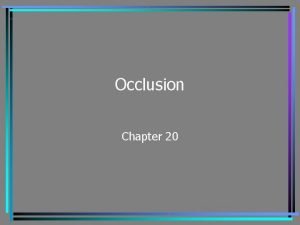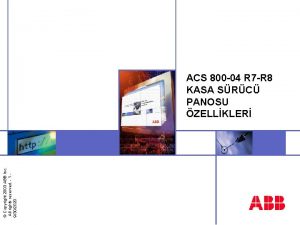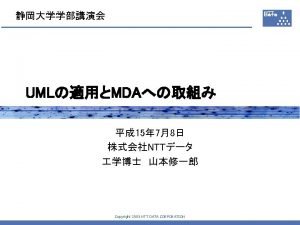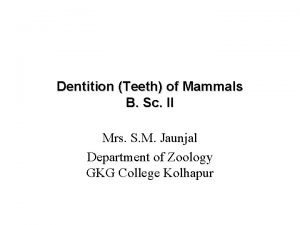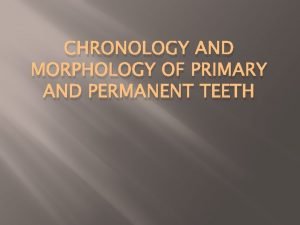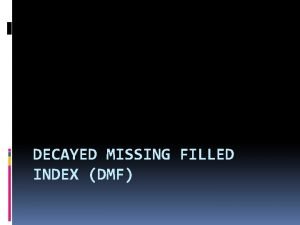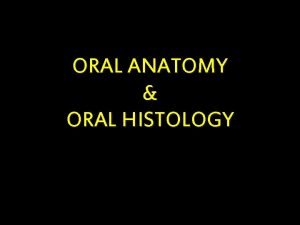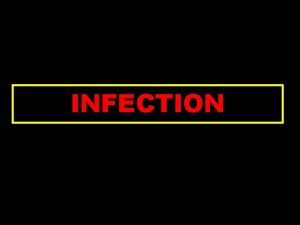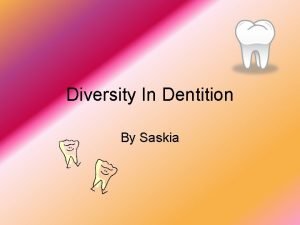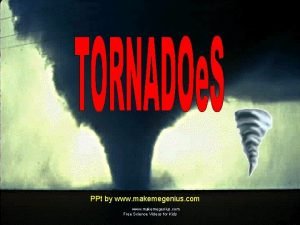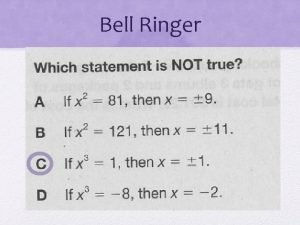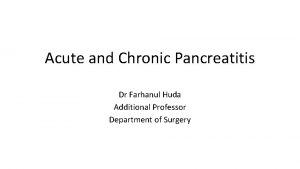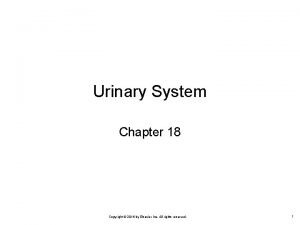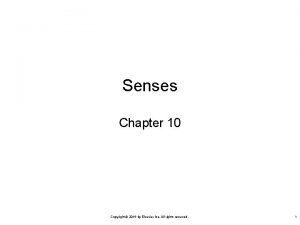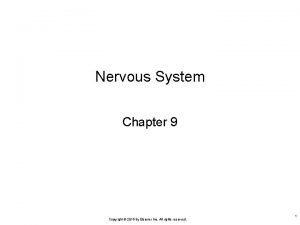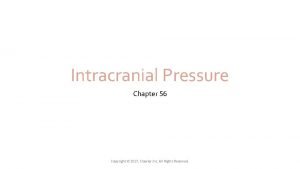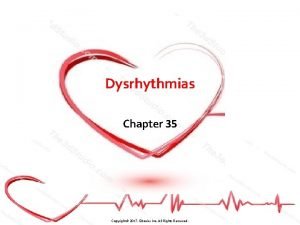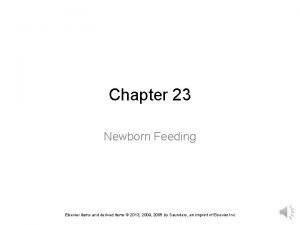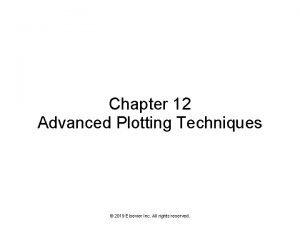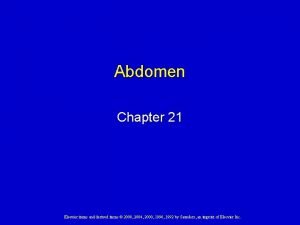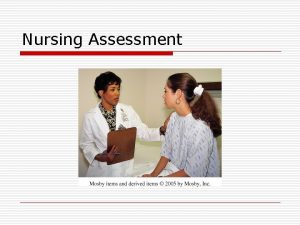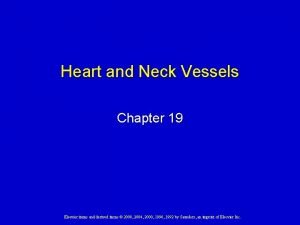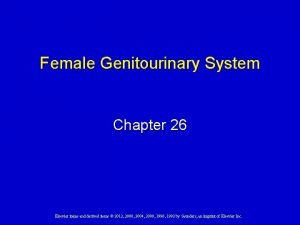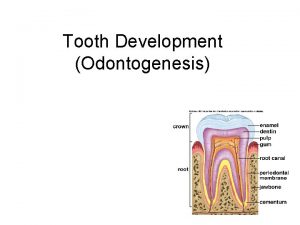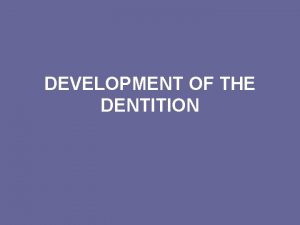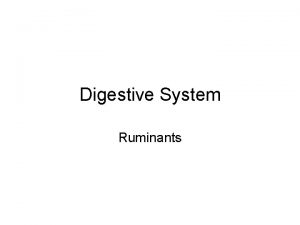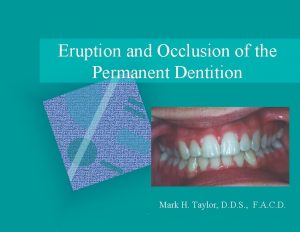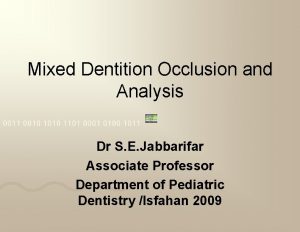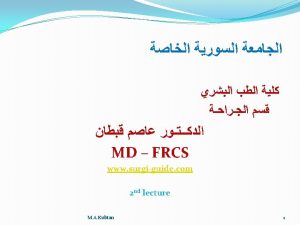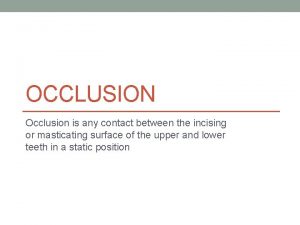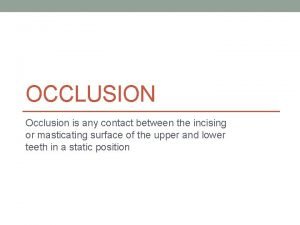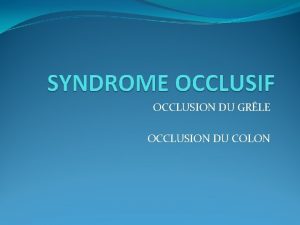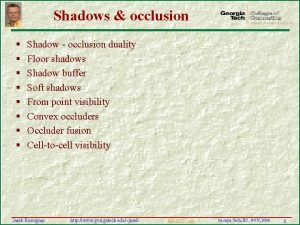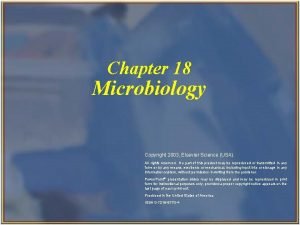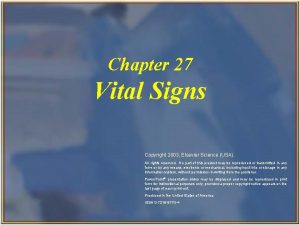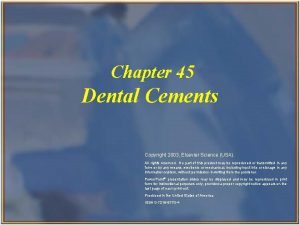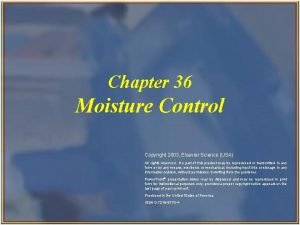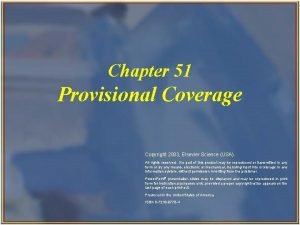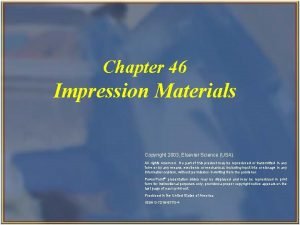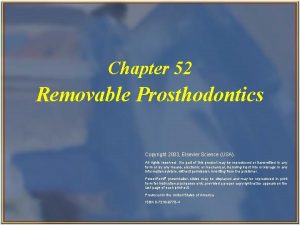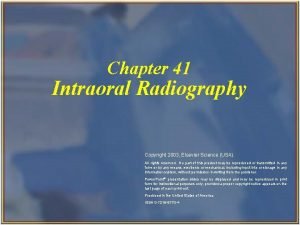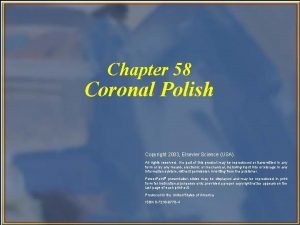Chapter 11 Dentition Occlusion Copyright 2003 Elsevier Science









































- Slides: 41

Chapter 11 Dentition & Occlusion Copyright 2003, Elsevier Science (USA). All rights reserved. No part of this product may be reproduced or transmitted in any form or by any means, electronic or mechanical, including input into or storage in any information system, without permission in writing from the publisher. Power. Point® presentation slides may be displayed and may be reproduced in print form for instructional purposes only, provided a proper copyright notice appears on the last page of each print-out. Produced in the United States of America ISBN 0 -7216 -9770 -4

Introduction Dentition describes the natural teeth in the jawbones. The dental assistant must know the names, locations, and functions of the teeth. The dental assistant must also understand the various systems of numbering the teeth, as well as the patterns of tooth eruption and occlusion. Copyright 2003, Elsevier Science (USA). All rights reserved.

The Dentitions n Primary dentition n Mixed dentition n Permanent dentition Copyright 2003, Elsevier Science (USA). All rights reserved.

The Mixed Dentition n Occurs between approximately 6 and 12 years of age. Both primary and permanent teeth are present during this transitional period. The mixed dentition period begins with the eruption of the first permanent tooth, which is a permanent mandibular first molar. This period ends with shedding of the last primary tooth. Copyright 2003, Elsevier Science (USA). All rights reserved.

The Permanent Dentition n n The permanent dentition is the final or adult dentition. This period begins with shedding of the last primary tooth. Growth of the jawbones slows and eventually stops. There is very little growth of the jaw overall during this period because puberty has passed. Copyright 2003, Elsevier Science (USA). All rights reserved.

The Dental Arches n n n The maxillary arch (upper) is actually part of the skull and is fixed and not capable of movement. The teeth are set in the maxilla bone. The mandibular arch (lower) is capable of movement through the action of the TMJ. The mandible is the bone that supports the lower arch of teeth, thus the name mandibular arch. Occlusion is the natural contact between the maxillary and mandibular teeth in all positions. Copyright 2003, Elsevier Science (USA). All rights reserved.

Quadrants n n When the maxillary and mandibular arches are each divided into halves, there are four sections, which are called quadrants. Each quadrant of permanent dentition contains eight permanent teeth and a quadrant of primary dentition contains 5 teeth. Copyright 2003, Elsevier Science (USA). All rights reserved.

Fig. 11 -4 The midline, quadrants, anterior teeth, and posterior teeth. Fig. 11 -4 Copyright 2003, Elsevier Science (USA). All rights reserved.

Sextants n Sometimes it is necessary to divide the dentition into 6 parts; each part is called a sextant. • Maxillary right posterior • Maxillary anterior • Maxillary left posterior • Mandibular right posterior • Mandibular anterior • Mandibular left posterior Copyright 2003, Elsevier Science (USA). All rights reserved.

Anterior Teeth n The anterior teeth are the incisors and canines. n They are visible when we smile. n These teeth are aligned to form a smooth, curving arc from the distal (back) of the canine on one side of the arch to the distal (back) of the canine on the opposite side. Copyright 2003, Elsevier Science (USA). All rights reserved.

Posterior Teeth n n n The premolars and molars. The posterior teeth are aligned with little or no curvature. These teeth appear to be in an almost straight line. Copyright 2003, Elsevier Science (USA). All rights reserved.

Types and Functions of Teeth n n n Humans eat both meat and plants. To accommodate this variety in diet, teeth are designed for cutting, tearing, and grinding different types of food. The permanent dentition is divided into four types of teeth: • Incisors • Canines • Premolars • Molars Copyright 2003, Elsevier Science (USA). All rights reserved.

Types of Teeth in the Primary Dentition n The primary dentition has: • Incisors • Canines • Molars n There are no premolars in the primary dentition. Copyright 2003, Elsevier Science (USA). All rights reserved.

Fig. 11 -5, A Occlusal view of the permanent dentition. 3 -4 Copyright 2003, Elsevier Science (USA). All rights reserved. Fig. 11 -5, A

Fig. 11 -5, B Occlusal view of the primary dentition. Fig. 11 -5, B Copyright 2003, Elsevier Science (USA). All rights reserved.

Incisor Teeth n n Are single-rooted teeth with a relatively sharp and thin edge. Located at the front of the mouth, they are designed to cut food without the application of heavy forces. Incisor means “that which makes an incision, or cut. ” The tongue side, or lingual surface, is shaped like a shovel to aid in guiding the food into the mouth. Copyright 2003, Elsevier Science (USA). All rights reserved.

Canine Teeth n Also known as cuspids. n Located at the "corner" of the arch. n Designed for cutting and tearing foods. n Are the longest teeth in the human dentition. n They have the longest root and are usually the last teeth to be lost. n Because of its sturdy crown, long root, and location in the arch, the canine is referred to as the cornerstone of the dental arch. Copyright 2003, Elsevier Science (USA). All rights reserved.

Premolar Teeth n n There are four maxillary and four mandibular premolars. The premolars, also known as bicuspids, are a cross between canines and molars. The pointed buccal cusps hold the food while the lingual cusps grind it. They are not as long as canines and they also have a broader surface for chewing food. Copyright 2003, Elsevier Science (USA). All rights reserved.

Molar Teeth n Molars are much larger than premolars, usually having four or more cusps. n The function of the 12 molars is to chew or grind up food. n n The molars have more cusps than the other teeth. There are four or five cusps on the occlusal (biting) surface of each molar, depending on its location. Maxillary and mandibular molars differ greatly from each other in shape, size, number of cusps, and roots. Copyright 2003, Elsevier Science (USA). All rights reserved.

Tooth Surfaces n Occlusal surfaces: Posterior teeth n Incisal surfaces: Anterior teeth n Lingual surfaces n Buccal or facial surfaces n Mesial surfaces n Distal surfaces Copyright 2003, Elsevier Science (USA). All rights reserved.

Fig. 11 -6 Surfaces of the teeth. Fig. 11 -6 Copyright 2003, Elsevier Science (USA). All rights reserved.

Anatomic Features of the Teeth n Anatomic features of the teeth help maintain their positions in the arch and protect the tissues during mastication. • Contours • Contacts • Embrasures Copyright 2003, Elsevier Science (USA). All rights reserved.

Fig. 11 -7 Tooth contours. Fig. 11 -7 Copyright 2003, Elsevier Science (USA). All rights reserved.

Embrasures n n When two teeth in the same arch contact, their curvatures next to the contact areas form spaces called embrasures. An embrasure is a triangular space in a gingival direction between the proximal surfaces of two adjoining teeth in contact. Embrasures are continuous with the interproximal spaces between the teeth. All tooth contours including contact areas and embrasures are important in the function and health of the oral tissues. Copyright 2003, Elsevier Science (USA). All rights reserved.

Fig. 11 -9 Embrasures may diverge facially, lingually, occlusally, or apically. Fig. 11 -9 Copyright 2003, Elsevier Science (USA). All rights reserved.

Line Angles n n n An angle is the junction of two or more surfaces of a tooth. A line angle is that angle formed by the junction of two surfaces of a tooth crown along an imaginary line. A point angle is that angle formed by the junction of three surfaces at one point. Copyright 2003, Elsevier Science (USA). All rights reserved.

Fig. 11 -10 Line angles and point angles. Fig. 11 -10 Copyright 2003, Elsevier Science (USA). All rights reserved.

Dividing the Tooth into Thirds n The root of the tooth is divided crosswise into thirds: • Apical third (nearest the tip of the root) • Middle third • Cervical third (nearest the neck of the tooth) Copyright 2003, Elsevier Science (USA). All rights reserved.

Fig. 11 -11 Anterior and posterior teeth divided into crown and root thirds. Fig. 11 -11 Copyright 2003, Elsevier Science (USA). All rights reserved.

Occlusion n n Occlusion is the relationship of the maxillary and mandibular teeth when the jaws are in a fully closed position. Occlusion develops in a child as the primary teeth erupt. 1. Habits such as thumb sucking or improper swallowing habits can affect the occlusion. 2. Proper occlusion of the erupting permanent teeth depend on the occlusion of the primary teeth as they are shed. Copyright 2003, Elsevier Science (USA). All rights reserved.

Types of Occlusion n Centric occlusion: The jaws are closed in a position that produces maximal stable contact between the occluding surfaces of the maxillary and mandibular teeth. Functional occlusion: The contact of the teeth during biting and chewing movements. Malocclusion: Abnormal or malpositioned relationships of the teeth. Copyright 2003, Elsevier Science (USA). All rights reserved.

Fig. 11 -12 Radiograph showing mesial drift of the mandibular second molar. Fig. 11 -12 Copyright 2003, Elsevier Science (USA). All rights reserved.

Angle's Classification of Malocclusions n Class I (neutroclusion) n Class II (distoclusion) • Class II, Division 1 • Class II, Division 2 n Class III (mesioclusion) Copyright 2003, Elsevier Science (USA). All rights reserved.

Stability of the Arches n n The dental arch is designed to be stable and efficient as long as its normal arrangement is maintained. Malocclusion or the loss of one or more teeth may greatly reduce the functioning and stability of the dentition. Curve of Spee is the maxillary and mandibular arches in occlusion. Curve of Wilson is defined by a line drawn across the occlusal surface of the left mandibular first molar, across the arch, and through the occlusal surface of the right mandibular first molar. Copyright 2003, Elsevier Science (USA). All rights reserved.

Fig. 11 -13, A The curve of spee. Fig. 11 -13, A Copyright 2003, Elsevier Science (USA). All rights reserved.

Fig. 11 -13, B The curve of Wilson. 3 -4 Copyright 2003, Elsevier Science (USA). All rights reserved. Fig. 11 -13, B

Tooth Numbering Systems n Universal/National Numbering System n Federation Dentaire Internationale (FDI) n Palmer Notation System Copyright 2003, Elsevier Science (USA). All rights reserved.

Universal/National Numbering System n Approved by the American Dental Association in 1968. n Most commonly used throughout the United States. n The permanent teeth are numbered from 1 to 32. n n Numbering begins with the upper right third molar, works around to the upper left third molar, drops to the lower left third molar, and works around to the lower right third molar. In the Universal Numbering System, the primary teeth are lettered with capital letters from A to T. Copyright 2003, Elsevier Science (USA). All rights reserved.

Dentaire Internationale (FDI) Numbering System n Uses a two digit tooth recording system. n The first digit indicates the quadrant and the second indicates the tooth within the quadrant. n The numbering is from the midline toward the posterior. n The permanent teeth are numbered as follows: • Maxillary right quadrant is #1 • Maxillary left quadrant is #2 • Mandibular left quadrant is #3 • Mandibular right quadrant is #4 Copyright 2003, Elsevier Science (USA). All rights reserved.

The Palmer Notation n Each of the four quadrants is given its own tooth bracket made up of a vertical line and a horizontal line. This system is a shorthand diagram of the teeth as if the patient’s teeth were being viewed from the outside. The teeth in the right quadrant would have the vertical midline bracket to the right of the tooth numbers or letters, just as when looking at the patient-the midline is to the right of the teeth in the right quadrant. Copyright 2003, Elsevier Science (USA). All rights reserved.

Fig. 11 -14 The Palmer Notation. Fig. 11 -14 Copyright 2003, Elsevier Science (USA). All rights reserved.
 Torsoversion tooth
Torsoversion tooth Semianatomic
Semianatomic Copyright 2003
Copyright 2003 Copyright 2003 pearson education inc
Copyright 2003 pearson education inc Copyright 2003
Copyright 2003 Copyright 2003
Copyright 2003 Predentate
Predentate Mammals dentition
Mammals dentition Class 1 canine relationship
Class 1 canine relationship Chronic hyperplastic candidiasis
Chronic hyperplastic candidiasis How to calculate dmft score
How to calculate dmft score Chapter 12 tooth morphology fill in the blank
Chapter 12 tooth morphology fill in the blank Linguo incisal ridge
Linguo incisal ridge Intact dentition
Intact dentition Cow is a herbivore or omnivore
Cow is a herbivore or omnivore What is your favourite subject
What is your favourite subject Scientific notation graphic organizer
Scientific notation graphic organizer Make me genius videos
Make me genius videos Copyright science stuff
Copyright science stuff Elsevier statdx
Elsevier statdx Tony askew
Tony askew Springer elsevier
Springer elsevier Elsevier clinical key
Elsevier clinical key Elsevier 2005
Elsevier 2005 Pancreatic calcification
Pancreatic calcification Descending limb of nephron loop
Descending limb of nephron loop General sense
General sense Elsevier
Elsevier Copyright
Copyright Ees elsevier
Ees elsevier Copyright
Copyright Picture for newborn
Picture for newborn Elsevier
Elsevier Elsevier
Elsevier Four quadrants of the abdomen
Four quadrants of the abdomen Elsevier
Elsevier Reaxys
Reaxys Elsevier
Elsevier Elsevier
Elsevier Elsevier
Elsevier Elsevier
Elsevier Elsevier china
Elsevier china
